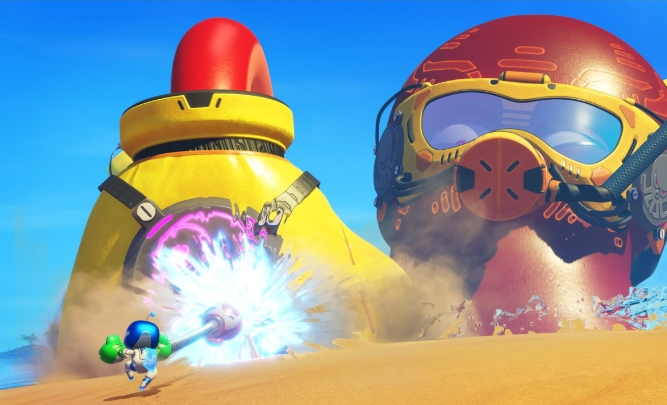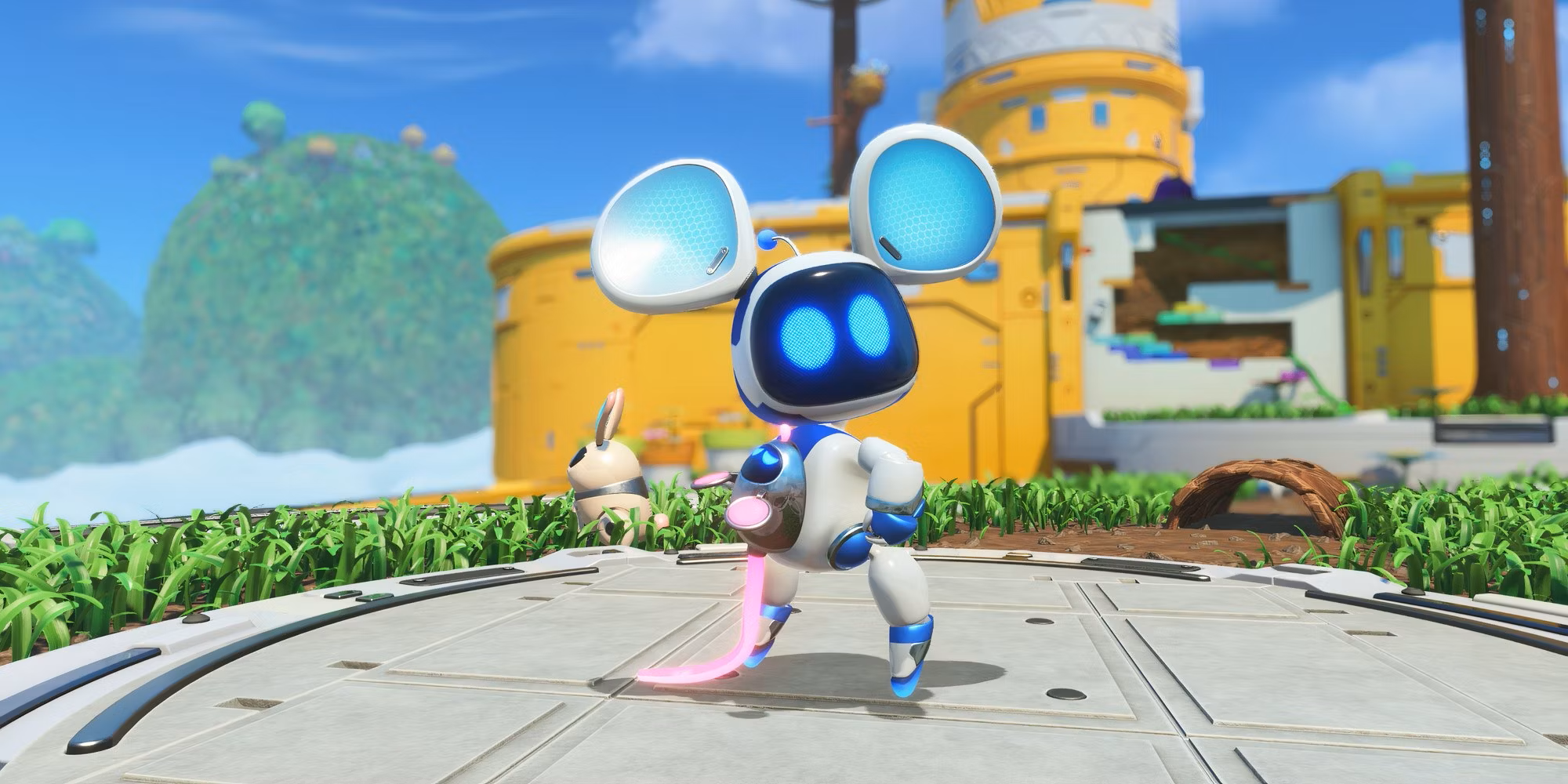ASTRO BOT IN DEPTH REVIEW
“Sony just shook up the hierarchy of best platformers while not only producing an instant game of the year candidate, but also captivated hearts worldwide with its not-so-new protagonist. An innovative yet nostalgic expedition of ASTROnomical delights.”
Astro Bot
Platform: PlayStation 5
Initial Release: September 6, 2024
Developer(s): Team ASOBI, Japan Studios
Price: $59.99
“A journey of a thousand miles begins with a single step”. This proverb rings loud and true for Team ASOBI as they are flung into AAA spotlight. The PlayStation first party studio got its start in 2013 with The Playroom, an augmented reality tech demo coinciding with the release of the PS4. The Playroom was comprised of a collection of mini games intended to demonstrate the PlayStation camera and DualShock 4. This would also be the first introduction to “Astro Bot”. Although at the time, the bot we would one day be gushing over, looked slightly different. There was no Astro, just bots. In the demo, a hoard of intentionally simple-looking designed bots would swarm and interact with the player in a very, “Gru commanding an army of Minions” kind a way.
In 2016 Team ASOBI provided Sony with another tech demo. This demonstration was called Playroom VR and was meant to show off the features of, as the name states, the PlayStation VR. The virtual reality demo is where our Bot started to catch some traction. A spin-off title of a beloved Robots Rescue mini game within Playroom VR, titled Astro Bot: Rescue Mission, set the stage for our little hero to rise apart from his mechanical brethren. Then in November of 2020, as the world began to come out of lockdown, we all came together for the launch of the PlayStation 5. With the launch of Sony’s newest flagship console, came the tech demo in which majority of this audience were most likely first introduced to Astro. Astro’s Playroom (finally a ‘game’ named after the protagonist) is still regarded as a must-play for players new to the console. Yet, Astro’s biggest adventure was just beyond the horizon.
If I asked what the best first party Playstation game is, what would you answer? Many folks would turn towards Sony Santa Monica’s, God of War (2018) or Naughty Dog’s, The Last of Us Part 2. If you answer anything other than Astro Bot, on paper, you would be wrong. At the time of writing this, Astro Bot is sitting at a score of 94 on review cite Metacritic and a 95 on Opencritic. Not only is this the highest scoring Playstation game across both sites ever, but it also statistically catapults its way onto the podium for best platformer. In Team ASOBI’s first true opportunity at creating an AAA game, it is safe to say, they knocked it out of the park. The developer’s new title rivals that of Celste, Guacamelee!, Hollow Knight, Sonic Mania, and even Super Mario Odyssey.
So, what is it that has both critics and players reviewing the game so highly? It starts with one word, pastiche. Merriam-Webster defines pastiche a “ a musical, literary, or artistic composition made up of selections from different works”. Astro Bot may be the greatest piece of pastiche ever conceived. The game borrows design from Super Mario Bros., having Astro visit different ‘worlds’ that each house their own levels. Within each level are power-ups akin to those found in later Mario World and Kirby games, needed for Astro to platform his way to the end. There are three types of collectibles in each level: coins (used as currency), puzzle pieces (used to unlock different shops within the hub world), and other bots.
There are over 300 bots to collect with 173 advertised as special bots, all dressed as characters from the PlayStation family past and present. Finding these bots felt like collecting Waddle Dees in Kirby and the Forgotten Land, but with nostalgic excitement every time a special bot is recognized. Every bot collected throughout the levels gets sent to a hub world called The Crash Site. And while it is fun to go around and interact with the bots here, there is a small chance that you will recognize every single one of them. If I have one complaint about the game it is that the record keeping system that keeps track of the bots collected, does not break down who the special bots are and the game(s) they are from. In a behind-the-scenes video posted on the PlayStation YouTube channel, Studio Director Nicola Doucet states, “One of the hopes we have is that the young generations will come across these special characters, then will be inspired to go to these older games and actually try them for themselves.” This goal would be easier to accomplish if there was an in-game mechanic who told you who they are.
A PlayStation fiesta of characters and hodgepodge of borrowed game mechanics blend seamlessly. While it may sound as if the game just copies the homework of all the games that came before it, that is simply not the case. Astro Bot takes every lesson these previous works taught, and precisely refines them with both overwhelming charm and genre re-defining innovation. The DualSense controller becomes an extension of the game as its haptic feedback technology allows the player to feel every step and jump Astro takes, with the sensation changing on every surface. The controller’s built-in speaker acts as surround sound to the world. Upbeat audio tracks, audible footsteps, interactive and combative noises all blend into a symphonic atmosphere that pulls you through each level.
Working in tandem with this are unique abilities specifically designed for each level, keeping each one feeling fresh. One standout being a Mouse power-up in a level titled Downsize Surprise. This ability sees Astro shrinking down to the size of a mouse and growing back to normal size at the command of a button. Not only does Astro’s height change, but the force perspective of the world changes with him. Allowing the tiny hero to parkour up leafy vines, ride floating bubbles, and zip across clotheslines that he would be too large to do at normal size. I found myself having ‘ah-ha’ moments repeatedly when it came to these power-ups. After spending time with one and getting used to it, players will find themselves in a different level using the same ability in a completely different way. For example, in one level Astro needs to turn into a metal ball in order to roll across beds of spikes, while another uses the ball ability to prevent Astro from being crushed by the jaws of a crocodile.
Pastiche creates an overwhelming sense of nostalgia. Innovation in audio and physics make for an all-around good gaming experience. And when it all collides, you are presented with some of the best moments the game has to offer. Two of these moments stand out to me in particular.
The first comes near the end of the first galaxy Astro visits. For context, each galaxy has a boss you will face at the end in order to obtain an item used to progress the story. The first galaxy, Gorilla Nebula, has you facing off with a giant mechanical gorilla named Mighty Chewy. It is in the last level before the boss fight, titled Construction Derby, that the player has their first encounter with the beast. The level sees Astro jumping and dashing through a live construction site atop a bunch of cranes and skyscrapers. Then suddenly the camera rotates and stills, transforming the level into a 2D side-scroller with Mighty Chewy chasing Astro with an open hand, ready to crush. I couldn’t help but draw a comparison between this and the original Donkey Kong arcade game. This comparison is further drawn when you actually clash with the behemoth who starts throwing items in the player’s path, to prevent Astro from reaching him. It’s in this moment that if you realized where the inspiration for this fight came from, you will find yourself breathtakingly admiring just how far video games have come.
The second highlighted moment comes after Mighty Chewy has been vanquished. This is when you learn that there are not only special bots, but each galaxy has a special level completely inspired by a PlayStation game or series. These unique one-off levels also see Astro transmogging his abilities and appearance by borrowing an item from the character who inspired the special level. The attention to detail in these levels left me mesmerized. There were so many surprising elements that I was utterly confused as to how they pulled it off. Somehow, you were no longer playing Astro Bot, but were fully immersed in whatever game the developer wanted you to be in. Yet, the whimsical playfulness and cute charm was still there dancing perfectly in tune with another game without stepping on any toes.
The first of these levels allows Astro to borrow the Leviathan Axe from God of War’s Kratos. An electric-pop re-mix of a GoW soundtrack sets the mood. You press the R2 button to use your ability and it flies through the sky. Alas, it does not return. Anybody familiar with the game that gave life to this special level instantly understands what to do. The Leviathan Axe is thrown and recalled in the same manner as the aforementioned title. The sneaky green glow of Odin’s ravens can be obliterated. You blow into the mic of the DualSense, replicating the horn being blown to call upon the World Serpent. You smash three bell shaped enemies in a perfect line, as if they were preventing you from opening a chest. The axe is stuck into columns, freezing them in place to platform up. You never want levels like these to end. But when they do, you are driven to continue Astro’s journey in hopes you’ll run across another like it.
Astro Bot reaches towards perfection as it somehow flies close to the sun, with no fear of melting wings. The game is intended for a younger or family-based audience. It’s the type of game you would typically have no choice but turn to Nintendo for. A welcome to the PlayStation family, that normally pushes out more mature content. But don’t get it twisted; this game is an amazing experience for casual and hardcore gamers alike. Level design walks an invisible tightrope between fun and challenge, accommodating both groups. And for those who would like to face an even higher difficulty, already announced DLCs will be adding more challenge levels and speed trials along with some new special bots.
While the protagonist may seem plain in design compared to a mustached plumber or chilidog eating hedgehog, Astro is memorable in his own rights. I have said a lot of words, but none truly capture the emotions of curiosity and bliss felt while playing. Gameplay Programmer, Akira Ishii speaks on this better than I ever could. He explains, “This ASTRO BOT is a love letter to our game fans…We created this game with love, and we hope the love letter reaches everyone”. That love and heart that the developers bled into the game, left me with a smile on my face the entire time. And after obtaining the game’s coveted platinum trophy and moving on to something new, I couldn’t help but feel as if I had said goodbye to a dear friend. As I reflect on the memories shared with the bot, I could not view Astro Bot as anything other than a masterpiece. I only hope my friend is ready to collect some well-deserved trophies of his own.





